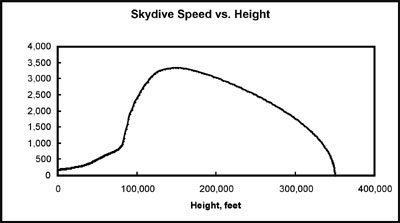|
|
 A chart showing speed as a function of altitude for an extreme skydiver. (credit: J. Jurist) |
Human factors in commercial suborbital flight: Impact acceleration: an extreme skydiving experience
by John Jurist
Monday, July 18, 2005
The previous column discussed the effects of long term accelerations such as those experienced during motor burn or re-entry of a commercial space vehicle. (See “Human factors in commercial suborbital flight: What does acceleration do to the human body?”, The Space Review, July 5, 2005.) This column will deal with the effects of short duration accelerations or impacts. These effects are relevant to dealing with possible in-flight emergencies or aborted flights.
Accelerations of short duration (under perhaps 200 milliseconds) do not involve significant fluid shifts within the body, nor do they involve the various reflex responses that can affect responses to longer duration acceleration. Instead, the forces applied to human tissues are proportional to the applied acceleration. If the tissue tolerances are exceeded, mechanical injury occurs. However, experiments with animals and unembalmed human cadavers have shown than the acceleration tolerance for a given impact scenario tends to decrease as the time of application of the acceleration increases. Below acceleration durations of perhaps 50 to 100 milliseconds, the acceleration tolerance versus time curve tends to follow lines of constant velocity change, or delta-v. This is a result of the viscoelastic nature of most tissues: that is, the loading stress required to cause the tissue to fail increases with the applied strain rate. This effect can be quite significant. For example, the energy absorbed by a human tibia (shin bone) before it fractures is about 30 to 50 percent higher for loads applied within 50 milliseconds as compared to loads applied over many seconds.
What are the basic impact tolerances for well secured and well positioned humans? Work pioneered by the late John Paul Stapp and others over the past half century has established these limits for human subjects, cadavers, and assorted animal models. Plus Gz (eyeballs down) of a well-positioned (not bent forward) person is up to about +30 Gz applied at rates of up to about 500 G/sec. Minus Gz (eyeballs up) can be tolerated up to about –15 Gz applied at up to about 200 G/sec. Plus Gx (eyeballs in) can be tolerated up to about +40 Gx for up to about 250 milliseconds. Minus Gx (eyeballs out) can be tolerated up to about –40 Gx for up to about 150 milliseconds and –25 Gx for up to about one second.
| Frefall from 100 kilometers would be quite a memorable ride, but thermal protection at extremes of cold and high stagnation temperatures (over 500°C) for the five- or six-minute ride will be required. |
Consider a commercial spaceflight passenger who bails out of a suborbital vehicle at apogee (effectively zero speed), 105 kilometers above the ground, and falls free. This could potentially be a result of some type of failure mode or elective as a form of extreme skydiving. Further, ignore the problems of maintaining stability but instead assume that the spread-eagled passenger either faces up to enjoy the sky and experience +Gx or faces down to enjoy the view of the approaching ground and experience –Gx. What kinds of dynamic loading does this individual experience as a result of air drag?
For the first 73 seconds, he or she experiences microgravity at less than one percent of normal gravity. During that time, he or she descends to about 81,300 meters and accelerates to a speed of about 695 meters/second. As the descent continues, the intrepid skydiver accelerates up to a maximum speed of about 1,000 meters/second (Mach 3) 114 seconds into the fall at an altitude of about 45,400 feet. He or she then decelerates until crossing 9,000 meters into modestly decent atmosphere 243 seconds into the fall at a speed of about 90 meters/second. The skydiver crosses 3,000 meters at 63 meters/second 325 seconds into the jump.
During the fall, 22 seconds are spent at acceleration levels above 2 G, 18 seconds are above 3 G, 13 seconds are above 4 G, and 6 seconds are above 5 G. Maximum acceleration is about 5.8 G at 137 seconds into the fall and an altitude of about 26,500 meters.
That would be quite a memorable ride, but thermal protection at extremes of cold and high stagnation temperatures (over 500°C) for the five- or six-minute ride will be required. A pressure suit is also required. Stability during the free fall is a problem, particularly during the high acceleration phases of entry into denser atmosphere. If the skydiver enters a flat spin, blood is effectively centrifuged into the extremities. The human tolerance to a flat spin is about 140 RPM, and uncontrolled spin rates of up to about 200 RPM can occur. Spinning can produce vertigo and result in nausea and vomiting. This is both unpleasant and dangerous in a pressure suit and/or oxygen mask.
The first extreme skydiver was Joseph Kittinger in the late 1950s as part of the USAF Project Excelsior. He jumped from balloons at altitudes of about 30,000 meters.
The next column will consider some failure modes and their dynamic implications for a potential passenger.
John Jurist is a biophysicist with a long-standing interest in human factors. He currently resides in Billings, Montana and can be contacted at JMJSpace@aol.com. Any of the opinions expressed in these columns are his own and do not necessarily reflect the opinions or policies of XCOR Aerospace, Montana State University, or Santa Clara University.
|
|
